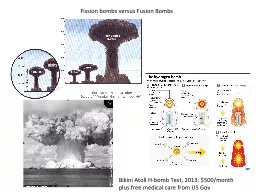

Bikini Atoll Hbomb Test 2013 500month plus free medical care from US Gov Todays Plan Particle Detectors Bubble Chamber example Cherenkov radiation Quiz Elements of a multipurpose particle spectrometer ID: 756213
Download Presentation The PPT/PDF document "Fission bombs versus Fusion Bombs" is the property of its rightful owner. Permission is granted to download and print the materials on this web site for personal, non-commercial use only, and to display it on your personal computer provided you do not modify the materials and that you retain all copyright notices contained in the materials. By downloading content from our website, you accept the terms of this agreement.
Slide1
Fission bombs versus Fusion Bombs
Bikini Atoll H-bomb Test, 2013: $500/month plus free medical care from US
GovSlide2
Today’s Plan
Particle Detectors
Bubble Chamber exampleCherenkov radiation QuizSlide3
Elements of a multi-purpose particle spectrometer
Vertexing
(measure displaced vertices due to weak interaction decays). Silicon strip and pixel detectors.Tracking (measure charged tracks in a magnetic field;
use the radius of curvature to deduce the momentum)Particle identification
(Use Cerenkov emission or time of flight (TOF)) to distinguish
pions
from
kaons
etc…Calorimetry (measure energy deposited in electromagnetic or hadronic showers)Muons (measure muons that penetrate steel or other heavy absorber).
Special purposeexperiments also have some of these componentsSlide4
A bubble chamber photograph
Donald Glaser,
1960 Nobel Prize in Physics for the bubble chamber
1968 Physics Nobel for Luis Alvarez:
"for his decisive contributions to elementary particle physics, in particular
the discovery of a large number of resonance states
, made possible through his development of the technique of using
hydrogen bubble chamber
and data analysis"
Fermilab
bubble chamberSlide5
How to measure the radius of curvature and momentum from
three points
in a bubble chamber or tracking detector. From the radius curvature or sagitta one can obtain the momentum.
Taylor expansion
cos
θ
≈
1
– θ2/2
So measure the “
sagitta
”, s, and determine p
R
RSlide6
The Geiger counter/The Proportional Counter
Two versions:
An avalanche discharge is produced near the wire (independent of the charge deposited).
When operated in proportional mode at lower HV (the ionization is proportional to the charge deposited in the tube).
Question: What is the E field produced near a wire in a cylinder ?
What is the potential difference across the tube ?
Ans
: E~1/r,
integrate to obtain ΔV=ln
(r0/ra)
Wire at positive HV; Why ?Slide7
Multi-wire proportional chamber (MWPC)
Georges
Charpak
, 1992 Nobel Prize in Physics
10
5
amplification factor near the wire.
Can cover large areas with planes of MWPC’s. This enabled many discoveries and fundamental experiments in particle physics.Slide8
MWPCs were followed by Drift Chambers
Similar to MWPC’s but provide two coordinates (one from the drift time of the ionization cloud to the wire. (spatial resolution is ~3 X times better than a MWPC).
MWPC’s can handle higher rates than drift chambers. Solid state detectors based on silicon are even more robust.Slide9
A fixed target experiment
Uses dipole magnets as momentum analyzers (“prisms”) and drift chambers and MWPC for tracking
In the case of a non-uniform B field or multiple magnets
A single dipole with field BSlide10
TPC (Time Projection Chambers)
Alessandro
Bettini
(left) and Dave
Nygren
(right), inventor of the TPC
Principle of the time projection chamber
3-D tracking AND
dE
/dx measurements.ATLAS
Also used by Prof.
Vahsen
for directional dark matter detection.Slide11Slide12
What is the vector momentum of each pion ?
Argonne Bubble Chamber event
Measure the radii of curvature and scale.Slide13
Let’s now calculate the energy momentum 4-vectors for each pion
.
However, the mass of the K
0
meson is 497.7 MeV
How do we calculate the invariant mass of the pi-pi system ?Slide14
We identified the π
+ π- parent, it is a K
0 meson !
Let’s try to identify the X particle.
Question: how can we do this ?
Introduce missing mass
Let’s calculate
E
miss
firstSlide15
Compare to known strange particles
Aha, the missing X particle is a
Σ
.Slide16
Shielding by dipoles on left
1934 Nobel Prize in Physics,
Pavel
CherenkovSlide17
Cherenkov radiation: another mechanism for relativistic charged particles
If a particle travels faster than the phase velocity (“speed”) of light in a medium, Cherenkov radiation is produced.
Recall n=c/v, where n is the index of refraction.
OB=
ct
/n (Cherenkov
wavefronts
)
OA=vt (particle moving to the right)
How does C radiation depend on frequency ?Slide18
Cerenkov radiation by electrons
Cerenkov radiation by electrons (few MeV range) produces the “spooky blue glow” in the cooling pools of nuclear reactors
Optical analogue of sonic boom
Radiation comes out in a cone in 3d
Remember the frequency dependence.Slide19
The phototubes in the
SuperKamkiokande
detector being serviced. The detector is located at the Kamioka
mine in Gifu prefecture, Japan
Cerenkov detectors can operate
in the
threshold
mode
orIn the ring imaging mode
Question: What is meant by threshold mode ?Slide20
Particle identification using Cerenkov radiation
Question: What is this event display ?
Bettini
p42
For water, n=1.33, the Cerenkov threshold is
E=0.775 MeV for electrons;
E=213 MeV for
muonsSlide21Slide22
Example: In the experiment of O. Chamberlain et al in which the anti-proton was discovered, the anti-proton momentum was approximately p=1.2
GeV. What is the minimum refractive index needed to have the antiprotons above Cerenkov
threshold ?
Need γ and then β. How we do find
γ
? Slide23
EM shower development in a calorimeter
From Rossi, B. (1952);
High-Energy Particles
; Prentice-Hall